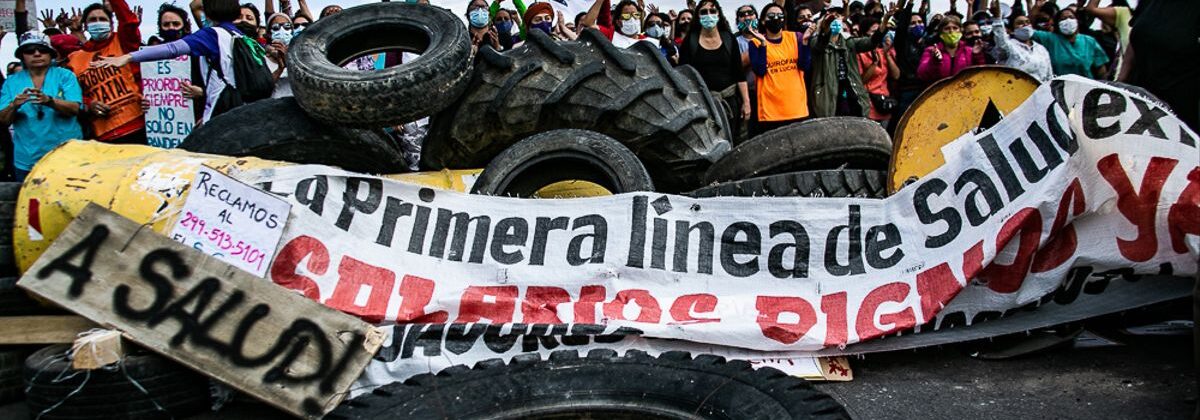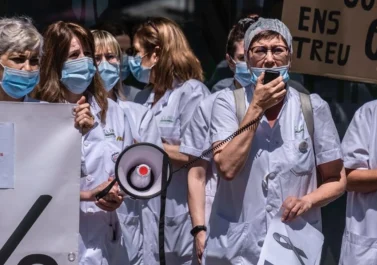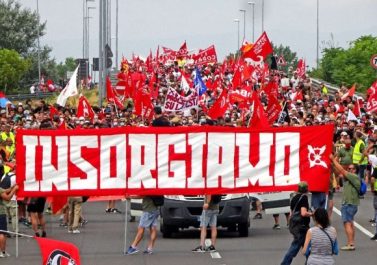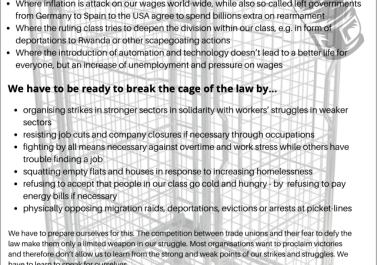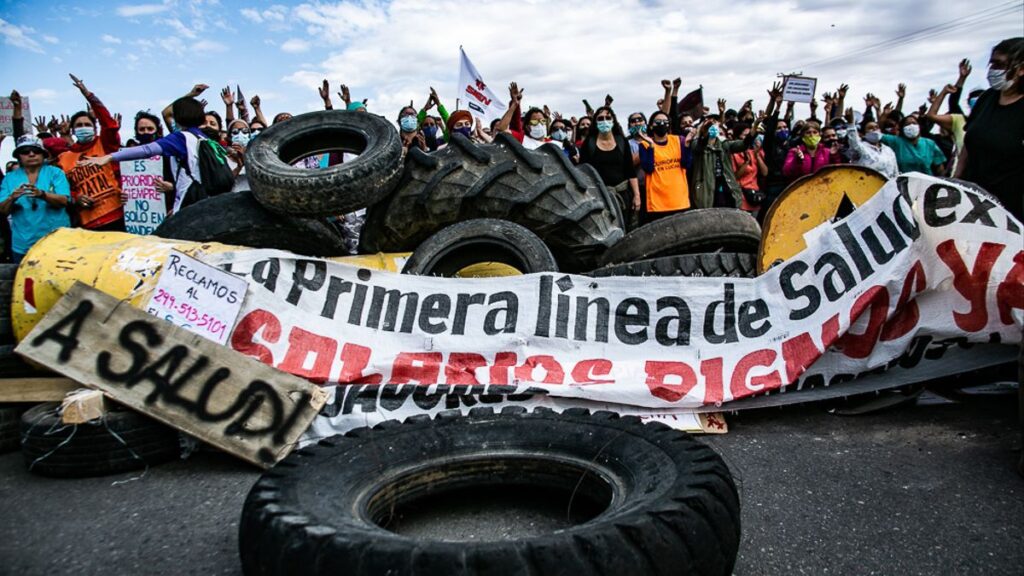
This is a longer version of a leaflet that we wrote together with friends of HealthWorkersUnited for the current pay campaign in general and the day of action on the 3rd of July in concrete. If you want us to send you copies for your local protests, please contact us at: healthworkersunited@protonmail.com
——–
We don’t have to tell you anything new about the situation. We all lost 10% pay in real terms since 2010, the 1% or even 4% pay offer is a disgrace, inflation is rising. There is enough money floating about, but it ends up in the wrong pockets, of this or that CEO or investor or friend of No.10. Where the money ends up, whether in our or their pocket, is a question of power. How can we develop our power?
Power is different from appealing or lobbying. They won’t give us more money because we did a great job during the pandemic and people clapped for us. They won’t pay us because we are kind and gentle souls. They won’t pay us because this or that MP puts a word in for us or we have 100,000 followers on twitter. They won’t feel enough pressure if we just go on another one-day protest march.
The only chance we have is to put real pressure on. A lot of work we do creates profits for trusts and indirectly for outsourced companies. We can go on strike, other health workers around the globe do it every day, without putting patients’ lives at risk. True, we don’t work in a car factory or bank call centre, we care for sick people. But we ourselves know best which work is immediately necessary to save lives and which work isn’t.
There are other ways to put pressure on too. In Argentina, health workers recently mobilised other working class people and together they blocked access to the local oil fields, demanding higher wages and better health services for everyone. We might not find an oil field nearby, but an Amazon depot might do or the morning rush-hour into the financial district!
Any action requires a degree of confidence and unity. Everyone will tell you that this is lacking. We have to find ways to organise ourselves, which help us regain trust in each other and ourselves. Often we can find some collective spark when we look at how we worked together during the first months of the pandemic. It was us together who got us through those days, while management and politicians were fumbling around. Together we know how to work with substandard equipment and unclear guidelines, we kept the show running. On some wards, in some hospitals our fellow workers enforced health and safety standards, an increase in (bank) staffing levels and bonus payments. That is a start.
The way work is organised and even how the unions are organised creates divisions. Divisions between different professional groups, various bands, in-house and outsourced workers, this union or that union. We need to form assemblies and open meetings on a hospital level, where all workers can come together and discuss how to go forward. We need to think about how we can do this in the community too, where we can be even more dispersed and disconnected from our fellow workers.
Health workers have done it before, we can do it again. Even before the existence of social media and mobile phones, health workers in France and Germany in the late 1980s formed such assemblies and connected them in a national coordination – see the short article about this on our website. It was not the various union headquarters who decided what the struggle should be for and how it should be conducted, but the health workers themselves.
We already see some problems with the union divisions. In Scotland, Unison recommended to accept a 4% pay offer, while other unions refused. What kind of signal is this to the politicians and managers?! Yes, we demand £2,000 annual increase officially, but if you throw us a bone, we take it?! The RCN might be willing to mobilise the nurses, but they are not too interested what is happening to healthcare assistants, porters or cleaners. There have been many strike actions of support staff – from porters at Cumberland trust to lab workers at Blackburn hospital – but these struggles remained isolated, not just within their own hospital, but even within their own union. We need forms of struggle that bring us together and allow us to discuss where to go.
We have to use this mobilisation to raise all the other concerns we have. It’s not just about the money, it’s about how we work and live our lives! The constant stress and rushing, because there is too much work. The hierarchies that stop us from really working together. The way that this makes us sick ourselves. The fact that with all the stressed health workers and the cut in money hospitals become places where patients get sicker, rather than better. We can see that most of the patients have been made sick by this stressful, depressing society, where it’s dog-eat-dog rather than living together. Hospitals and clinics are treated like the garbage bins for this society. We can raise all this together with the patients!
What can we do here and now?
- Meet with your co-workers who you know and trust and discuss the situation. Who else do you know in the workplace? What are the unions doing? Are there other groups involved in the pay campaign?
- If the unions are not prepared to set up a hospital meeting open to all workers, put pressure on them to do it. If they refuse, call for a meeting yourselves. Discuss how you can put pressure on management to pay you more. Management will say that ‘this is a national issue, it’s the politicians who decide’. Of course they will say that. But it is possible to go on a legal strike for a 15% ‘recruitment and retention payments’ even on a NHS trust level. In some hospitals, management increased bonus payments during the pandemic, reacting to pressure from below. Don’t let them fool you by saying that ‘wages are only decided at a national level’.
- Invite patients and other local working class people to your meeting. Ask them what they can do to support a common cause for better working and living conditions. Have a look if there are other struggles in the area, for example against fire-and-rehire or against school closures, and link up with the people involved. See how you can make each other stronger.
- Link up with people in other trusts. There are already some Facebook and campaign groups, but it’s best to also find ways to meet face to face. Each hospital or trust can send delegates who represent not their own opinion, but what has been discussed and decided on a hospital and trust level. These delegate meetings can then coordinate wider actions.
All this might sound pretty big, but workers have done it before and they are doing it elsewhere. We have to learn from these experiences and share our own stories of small steps of resistance that we take ourselves. You can find some examples below.
All this won’t be done in a day. But we will need these kind of structures for the future. We need more solidarity and support in our lives. We, the people who keep things running, keep people warm and fed and care for them should run the show. We need working class power and control over the means for a better life for all.
If you feel similar, get in touch! We are a network of workers in the health sector. We are not yet another organisation who wants you to become a member, but want to discuss our experiences at work and in struggle together. We want to find ways that help us and our fellow workers to gain control over our own struggles.
healthworkersunited@protonmail.com
@healthworkersu1
http://www.healthworkersunited.wordpress.com
————————
The following reports describe small and large actions taken by health workers. Some actions have been taken by local workers, some abroad. Some were taken in the past, some today. However small the action, we can learn from them. We always want to hear about your experiences.
Recent local actions…
- Action by ITU nurses to increase bank payments
In this particular ITU, some of the staff saw that the use of agency nurses was increasing. There had also been some concerns that paperwork wasn’t always being completed by the agency staff and, therefore, permanent staff were also having to pick up more work. A nurse put together some costings that proved if the trust were to increase the rate of pay for bank shifts for their permanent staff, then the uptake of these shifts would be greater and the need for agency staff would be less – with an overall cost reduction. This was agreed on by management and staff began to pick up more bank shifts.
This went on for a few months. But then management decided they would no longer be willing to stick to this pay increase and the bank incentives were removed. As a result, ITU staff decided to cancel their bank shifts on ITU as a protest against the removal of the incentives. The result of this was that there were more agency nurses needed and also gaps in the rota. This forced management to increase the pay for bank ITU staff permanently.
There are around 250 permanent nurses in intensive care, with about half of those regularly picking up bank work (one shift a month or more). This short report raises important issues for our current struggle for higher wages. The action of the nurses shows that management reacts to collective pressure from below, even if only a small group of workers are involved. It also shows that we have to overcome a few barriers to broaden the struggle. We see the division between the local ITU nurses and the agency staff – the ITU nurses want to prove that they are more ‘cost effective’, while some of the agency nurses might not have been interested in the general work atmosphere, as they ‘stay only for a few shifts’. We need to address and overcome these divisions.
- Apprenticeship scam in Bristol
The trust where I work employs over 500 apprentices who earn only 75% of the band 2 wage, but actually do pretty much a normal job. Most of the stuff we need to learn, be it as HCAs or housekeepers, is learnt on the job. Because the government supports apprenticeships and because they have to justify the 25% pay cut, they say that 20% of our working time is ‘off-the-job’ learning. In reality we’re told to write down any odd thing as ‘off-the-job’. If someone tells you how to make toast or hold hands with someone on the dementia ward, just write it down as ‘off-the-job!’ Because the wards are so busy, even during nights, they ask you to fill work books in ‘in your own time’. If you complain and say that you might leave the scheme, they say that you have to pay back the apprentice wages! People who had years of experience working as health carers, but didn’t have the right ‘certificate’ were forced to enter the apprenticeship. It’s basically a scam to cut your wages by a quarter for a whole year or longer. Up to now, everyone seems to be playing along. We need a meeting of apprentices to discuss the situation!
- Resistance against cuts by mental health workers in London
In 2018, a UK homeless mental health team campaigned against cutbacks by bonding together with local hospital & community services. Their tactics included workers gathering testimonies to give to decision-makers to show how cuts would be harmful. The coverage in a national broadsheet drew professional, academic and community support, which in turn led to commissioners/leaders having to defend the cuts in a public deputation. These actions helped offset the majority of cuts and assisted workers to share their experiences and support with others facing similar challenges across a wider mental health service.
- Successful strike at St.Mary’s hospital in London
For years, the cleaners, caterers and porters at St. Mary’s Hospital in west London, had been treated appallingly by French multinational Sodexo. Low wages, unpaid overtime, only the legal minimum sick pay. In October 2019 that began to change. As a group of 200 workers went out on what would go on to be one of the longest strikes in NHS history. Their demands were simple: to be made direct employees of the NHS and to enjoy the same pay and rights as other NHS staff. They were told by management that this was impossible. But after just three days of striking they won what they had also been told was impossible: the London Living Wage. But these workers would not allow themselves to be bought off. They persevered, together with their union UVW. They occupied hospital corridors, and on the 9th and final day of strike action stormed an executive board meeting to finally make the NHS managers listen to the horrors of working for Sodexo. The victory resulted in 1,200 workers across five hospitals being made direct employees of the NHS with each of them receiving a pay rise of several thousand Pounds and vastly improved terms and conditions.
Struggles abroad…
- Health workers’ rebellion in Argentina: “Let’s block the roads to the oil fields!”
In February 2021, the public workers trade union (ATE) and the local government in Neuquen agreed to a 12% pay increase for health workers. Workers were angry about this deal, partly because of high inflation, but also because the union leadership had ignored the hospital assemblies who wanted to refuse the pay offer.
On the 2nd of March workers from hospitals of the whole region met for a ‘general assembly’ in the main public square. They decide to go on strike without waiting for permission from the union. They demand a 40% pay increase, permanent contracts for agency workers, and better health and safety conditions. Their protests and strikes were joined by local teachers. When the local government offered an insulting 3% extra pay, workers and supporters started blocking the access roads to the main oil and fracking fields, to put an additional economic pressure on the state. They also blocked roads to the important tourist resorts. The blockade of the oil fields lasted for three weeks, and many truck drivers joined in support. The oil companies tried to fly workers in with helicopters, but had to close many oil wells.
After 55 days of struggle the government agreed a 53% pay increase, staggered till end of 2021. Workers say that they would never have been successful without the support of other working class people, such as teachers, factory workers and unemployed. These people hadn’t forgotten who cared for them during the pandemic and joined the street blockades. The final assembly, which ended in a music festival for everyone added another demand for future struggles: the introduction of the 6-hour day.
- Self-organisation of nurses in Czech Republic: Work-to-rule
Workers at NPK, a group of five hospitals in East Bohemia comprising over 5,000 workers, are in the process of organising their struggle. It is difficult: five hospitals mean different working conditions, wages, different work organisation, managements tactics. The initial reason for the struggle has been meagre Covid-19 bonuses, but this issue just opened the door to others: working conditions, wages, power hierarchies, repression by management. Petitions were circulating, sometimes signed by single, sometimes by several wards.
ICU units and anaesthetic nurses took the lead. Individual nurses and wards contacted the independent ‘Nurses’ Initiative’, which then got everyone in touch, at first over Zoom, then through direct meetings. The struggle was first discussed during a general meeting by one hundred workers at the beginning of May 2021. At the meeting, they decided to analyse each department where workers were present and see how workers could apply direct pressure on management, primarily through ‘work-to-rule’. Management is vulnerable to this tactic, because they compensate the lack of staff by breaking their own rules.
Workers had already gathered experiences with this method of ‘work-to-rule’ at KKN hospitals in West Bohemia during a long struggle in 2017/2018. The rebellious workers forced the local government, which is the owner of the hospital, to raise wages. This resulted, for example, in a 30% pay increase for experienced anaesthetic nurses between March 2017 and March 2018.
The struggle at KKN (as well as now at NPK) was led by Nurses´ Initiative, an independent self-organisation with their own workers’ newsletter founded in 2016. It was led outside of the official trade unions and even against them in necessary moments.
- Self-organisation of nurses in Germany: Collective actions against new shift-models
For the last ten years, a network of workers at a hospital in Dachau have been organising themselves independently. They organise their own meetings and a hospital newsletter, without support from the mainstream unions. They took various actions together. In 2012, management wanted to cut night-shift staffing levels on several wards, by introducing a 4-hour shift of nurses who just hand out medication. Management tried various divide-and-rule tactics, but wards supported each other and refused the new shift-model and sent a protest letter to management and the health authorities. They did this in opposition of their official representatives in the ‘works council’ (workers’ representative body).
In 2014, after the takeover of the hospital by the Helios corporation, management wanted to force workers to be ‘on call’ on two of their days off each month. This would have led not only to extra unpaid stress, but also to job cuts in the long run. Again they tried to introduce ‘test runs’ on a few selected wards, but wards coordinated with each other and all of them refused.
In 2017 the trade union called for a strike during the collective contract negotiations. The independent network managed to elect 90% of all strike committee delegates, which meant that all workers, not just union members, could be in the strike committee. The union initially didn’t want any pickets or noisy protests, but the delegates organised them anyway. They organised three spontaneous protest marches through town. They also marched to the trade union office to put pressure on the main trade union secretary during his visit, because they feared he would settle for a lower pay increase.
- Week-long strike of nurses at St.Vincent hospital in the USA
700 nurses at Saint Vincent Hospital in Worcester, Massachusetts have been on strike since the 8th of March 2021, demanding safe staffing for patients and higher wages. The private hospital company Tenet, has spent millions of dollars on the strike, including hiring replacement nurses and paying the Worcester Police Department $30,000 a day to patrol the picket line. The dispute has rumbled on for a long time, but Covid was the final straw. There was an absolute lack of staff.
So the nurses themselves organised the recovery room into an intensive care unit so all the COVID patients who needed critical care nursing could go to the ICU. In other hospitals in the US, workers went on spontaneous strikes and sit-down protests to enforce better PPE and more staff, too. Since Covid, there have been nearly a dozen health workers’ strikes in various private and non-profit hospitals. The workers at Tenet are committed, but they are increasingly isolated. The trade union Massachusetts Nurses Association (MNA) has around 23,000 members in the whole of the USA, but up to now they haven’t called any other workers to protest or go on strike in solidarity with their fellow workers in Worcester.
Struggles in the past…
- Nurses strike 1982 in the UK: Solidarity between workers breaks the law
In 1982, there was a pay dispute within the NHS by health workers including nurses, porters, clerical and auxiliary staff. Members of the COHSE and NUPE unions demanded a 12% pay rise, rejected by the government. Strikes began in May ’82, and became the largest dispute in NHS history. It consisted mainly of woman workers and has been largely ignored in the years since, unlike other disputes such as the miners.
During the strike, only emergency work was performed. New strike laws introduced in 1982 made secondary picketing or solidarity strikes of other workers illegal. Other unions ignored the law holding a 1 day sympathy strike, from shipyard to factory workers or schools and leisure centres across Britain. The largest ‘day of action’ on 22nd of September saw strikes closing most pits, disrupting the ITV network, automobile production and post offices. All this solidarity despite its illegality! However, the dispute was largely overshadowed by the British and Argentine bosses war in the South Atlantic, which gained predominant media attention. In the end, the negotiations became dominated by the RCN scab union, and the leaders of COHSE and NUPE lowered their demands. Although not all health workers got pay rises, some nurses got a 14% pay rise. However the government soon began privatising auxiliary services soon after.
- Nurses coordinations in France, 1988: A national coordination without Facebook and WhatsApp
In autumn 1988, the mainstream unions called for a symbolic strike and protest march of health workers. After the national demonstration, around 2,000 health workers met to form an independent coordination. The next strikes were called by this coordination directly, rather than the unions who were playing catch up.
Also, only 5% of health workers in France were members of unions at the time, so most of the strikers were not part of the unions in the first place. Local hospital assemblies and regional coordinations were the strike movement’s backbone. At the time, the workers had to organise all this without Facebook, Zoom or WhatsApp!
A typical pattern developed to make sure that the hospital assemblies remained the decision-making bodies, but didn’t get isolated: after each day of action on Thursday, the strike continued on Friday so that meetings could be held at the hospitals and delegates elected to go to the national coordination on Saturday. The demands were similar to our’s today: substantial pay increases and better staffing levels. Most of the demands were met by the government.
But there were also problems. In many cases the coordinations didn’t overcome the professional divisions. Only later on did nurses and support workers struggle together. The strike remained largely limited to the public sector hospitals, although the strikers demanded that the demands were also fulfilled in the private sector. While in Paris and other big cities, up to 90% of all nurses followed the strike call, numbers were much lower in the rural areas. The government also tried to split the coordination and offered some delegates advisory positions on the government health board. Still, there is a lot to learn from the experience back then. Shortly after the coordinations were formed in France, hospital workers in Germany formed similar structures. Even the nurses strike in the UK in 1988 can be seen as part of this international learning process.
